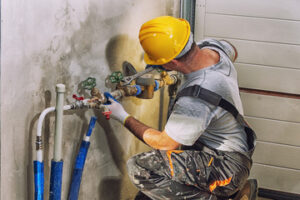The Electrical industry offers a variety of different opportunities for specialisation and progression. You can choose from union programs that are highly structured and offer benefits such as health insurance and retirement plans or non-union programs that allow more flexibility in the curriculum.

If you’re considering a career as an Electrician, start by completing a training program at a trade school. They will provide you with hands-on technical training and valuable insight from the industry. Contact Electrician Jacksonville NC for professional help.
An electrician is a skilled tradesperson who repairs, installs, and maintains electrical systems. They use a variety of hand and power tools, including wire strippers, pliers, conduit benders, and soldering irons. They also operate specialized equipment like logic analyzers and oscilloscopes. In addition, they must understand and adhere to state and local laws governing the industry.
Electricians must be able to read and interpret blueprints and technical diagrams. They must be able to follow wiring plans, install lighting fixtures and outlets, and connect circuits and wires. They may also need to be able to diagnose malfunctions and repair them. In addition, they need to stay apprised of revisions to building and safety regulations.
As a result, the job of an electrician can be physically demanding and require long periods on one’s feet or kneeling. It can also involve exposure to dust, fumes, and other hazardous materials. In addition, electricians must be able to work in cramped spaces and use heavy machinery. However, for those who love working with their hands and solving problems, this can be a fulfilling career choice.
Depending on the industry, electricians must be able to read and interpret diagrams. They also need to be able to work well under pressure and meet deadlines. They may need to travel to various locations to perform their duties, and they may be required to work on weekends and holidays. Some electricians also need to be able to climb ladders or scaffolding and work in tight spaces.
A clear and comprehensive electrician job description can help you attract the right candidates for your position. It should include salary information, benefits, and other details that can entice potential applicants. It should also be clear whether you expect the candidate to work on evenings or weekends, and if so, what the overtime rate will be. In addition, it should be clear whether the position offers opportunities for advancement and career training. Finally, the job description should clearly outline the qualifications and skills that the candidate needs to be successful in this role. These can include experience, licensing requirements, and education.
Education and training requirements
Electricians are skilled tradespeople whose expertise is crucial in a world increasingly dependent on electrical power. While formal education is not always a requirement, pursuing a degree in a relevant field can help improve an electrician’s prospects and capabilities. A popular choice is a major in electrical engineering, which provides a deep dive into the fundamental principles of electricity and electronics. Students with this degree are better equipped to tackle advanced installations and troubleshooting.
Other possible academic paths to a career as an electrician include attending a vocational school or community college, and completing an apprenticeship program. Vocational schools and community colleges often offer specialized programs that include instruction in electrical theory and safety measures, as well as hands-on experience. Many of these programs are also designed to connect students with job placement opportunities after graduation.
An apprenticeship is an essential part of becoming a fully-licensed electrician. It typically lasts four years and combines classroom instruction with practical work experience. In addition to classroom learning, apprentices are expected to follow local and national electrical code regulations. These requirements are essential to maintaining public safety and ensuring that electrical systems are installed correctly.
After completing an apprenticeship, an electrician can pursue a journeyman’s license by passing the NEC or National Electric Code exam. The NEC is a set of rules and guidelines that all electricians must know in order to safely and accurately perform their duties. Journeyman certification is a great way for electricians to advance in their careers, and it can help them secure higher wages and benefits.
While there are many different ways to become an electrician, the most common route is through a vocational or trade school. These schools provide a streamlined, efficient path to a successful career in the field, and they also offer financial assistance options. Vocational schools also have a strong network of employers and can facilitate job placement after completion.
In addition to technical skills, electricians must have a number of other qualities to be successful in the field. These include endurance, excellent math skills and physical strength. In addition, they must be able to read technical and wiring instructions, as well as blueprints and schematics. They also need to have perfect color vision, as all wiring is color-coded and must be correctly identified to avoid dangerous conditions.
Salary
An electrician’s salary can vary depending on a variety of factors, including location and experience. Those with more experience may earn more than those who are just starting out, and the salary can also vary by state. In general, electricians who work in metropolitan areas earn more than those who work in rural areas. Additionally, those who specialize in certain industries, such as oil and gas, may earn more than those who don’t.
In addition to the basic salary, electricians can receive bonuses, overtime pay, and commissions. These additional sources of income can significantly boost an electrician’s salary. Additionally, many electricians are eligible for retirement plans and health insurance. These benefits can make the job more attractive to potential applicants.
Electricians can also increase their earnings by obtaining additional qualifications or certifications. These can make them more valuable to their employers and may help them negotiate higher wages. In addition, electricians can also increase their salary by working in specialized fields such as solar energy or long-distance transmission lines.
To become a certified electrician, you must complete an apprenticeship and pass a state-approved test. Apprenticeships typically last 4-5 years and provide hands-on training under the supervision of a more experienced electrician. After completing an apprenticeship, you can then apply for a journeyman license in your state. The average salary for a journeyman electrician is around $69,000.
Licensed electricians are in high demand due to the need to replace aging infrastructure and install new technologies. They are also in demand by construction companies, as they are responsible for the installation and repair of electrical systems. As a result, their salaries are much higher than the average salary for all occupations.
In order to get the best possible salary, you should look for a position that provides a good benefit package and plenty of opportunities for advancement. You should also consider the cost of living in your area, as this will affect your final salary. Additionally, you should always seek out the highest-quality education and training possible to improve your chances of getting a well-paying job.
Work environment
Electricians can work in a variety of environments, and it’s important to find one that suits their needs. For example, if they prefer a structured indoor environment, residential work may be ideal. However, if they thrive in high-energy environments with fast-paced challenges, commercial or industrial work may be more appealing. It’s also important to consider whether they enjoy manual labor or are comfortable working in tight spaces when choosing a specialization.
A career as an electrician can be rewarding, but it’s also challenging due to the physical demands and safety risks. For this reason, it’s crucial for electricians to maintain a healthy work-life balance. This includes establishing firm boundaries around their schedules and prioritizing self-care activities, like exercise and rest. Additionally, a good work-life balance can help electricians manage stress levels and reduce burnout.
To become an electrician, you must first obtain a high school diploma or equivalent and complete a vocational training program that combines classroom learning with hands-on training. In addition, you must be able to read blueprints and troubleshoot electrical issues. Many electricians go on to pursue an apprenticeship, which offers invaluable experience and mentorship opportunities.
Once you’ve completed your education and training, you can start looking for work. You can typically find jobs through local listings or online employment agencies. Most electricians work as independent contractors, but you can also join a company to gain valuable skills and experience.
Depending on your area of specialty, you can expect to earn competitive wages. The demand for commercial and industrial electricians tends to be strong, so you’ll likely have a steady source of income. Moreover, the work is usually quite lucrative, especially for larger projects.
While the job can be challenging, it’s also very rewarding for those who are passionate about this profession. Many electricians enjoy the problem-solving aspect of the position and thrive in the physically demanding environments they often work in. However, the job can be stressful for those who are not comfortable with physical activity or working in tight spaces.
In addition to ensuring that all electrical work meets the highest safety standards, it’s also vital for Electricians to understand the importance of staying up-to-date with new technologies and trends. This will help them continue to develop their expertise and maintain a competitive edge.

